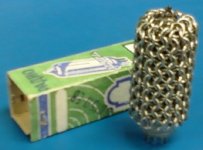Do glass envelope resonances have much effect on the metal electrodes inside?krellmk said:Silicone tube rings or whatever rings are often used to suppress resonances.
I guess that may depend on what exactly you mean by "tube-like" and "harmonious".They not only dampen the resonance, but do make the sound un-tube-like and less harmonious.
[FONT=Verdana, Arial, Helvetica, sans-serif]Silicone tube rings or whatever rings are often used to suppress resonances. They not only dampen the resonance, but do make the sound un-tube-like and less harmonious. [/FONT]
Never tried 'em myself, but I would suppose this would be more apropos to guitar amps where microphonic tubes in close proximity to the speaker might add some desirable "tone" to the sound.
Not sure what "un-tube-like" sounds like.
If there is any truth in the claims of improved 'ringing' rejection, surely the millions of valve amplifiers, that have been made for many years, would have them fitted as standard. Especially in the 50's and 60's when perfect noise rejection was the ultimate in fidelity.
Snakeoil and let's make loads of bucks from the suckers, comes quickly to mind here!
Snakeoil and let's make loads of bucks from the suckers, comes quickly to mind here!
if they are microphonic ,than they are deffective
Not defective, just cheap. The 6BQ7s that have series connected heaters, the ones with a thin filament between cathodes, ring like bells. These are by their construction, cheaper versions. Microphony wasn't a problem, given the original design purpose: Small signal, VHF amplification to 300MHz. Of course, I avoid these like the plague when I use 'em for non-standard, audio applications for which they were never intended, and audio isn't even mentioned in the spec sheets (though the 6BQ7 makes an excellent cascoded LTP).
Furthermore, all components are microphonic to one degree or another. I did a TRF xcvr project where all 100dbv of gain occurred in the audio subsystem. With that much gain, its op-amps and transistors made for noticeable and annoying microphonics, especially when the volume was too high. Nothing you can do about it besides trying to minimize the effect with good, solid construction practices.
In old times manufacturers used suspended sockets in for example reel to reel tape recorders to keep the mechanical noises , like motor vibrations generated ones away from the input tube, but those where almost exclusively pendodes with more electrodes and a bigger construction (EF86 or EF804). Today nobody uses anything else than triodes ,like the ECC83 or ECC88, much smaller electrodes and the later one with frame grid. And yes, if you put enough gain on your dinner table, it can be used as a microphone, some secret organizations using this technique with great success.
Some extra info on microphonics in link - there are ways to tame the beast if you need to tame it for starters - I hadn't seen the condom style before (which may rub off that Mullard label  )
)
http://dalmura.com.au/projects/Microphonics%20in%20valves.pdf
http://dalmura.com.au/projects/Microphonics%20in%20valves.pdf
simple logic, tubes are not manufactured to be microphonic, if they are than they are deffective
Wrong. Computer and some industrial tubes were manufactured without anti-microphonic structures, because it didn't matter and it was cheaper.
Other tubes have mica dampers to reduce the vibrations. For example, the ECC88 has internal mica dampers, while the industrial version E88CC / 6922 does not, and is more microphonic - some users prefer a little microphonic reverb...
- Status
- This old topic is closed. If you want to reopen this topic, contact a moderator using the "Report Post" button.
- Home
- Amplifiers
- Tubes / Valves
- Silicone tube rings
